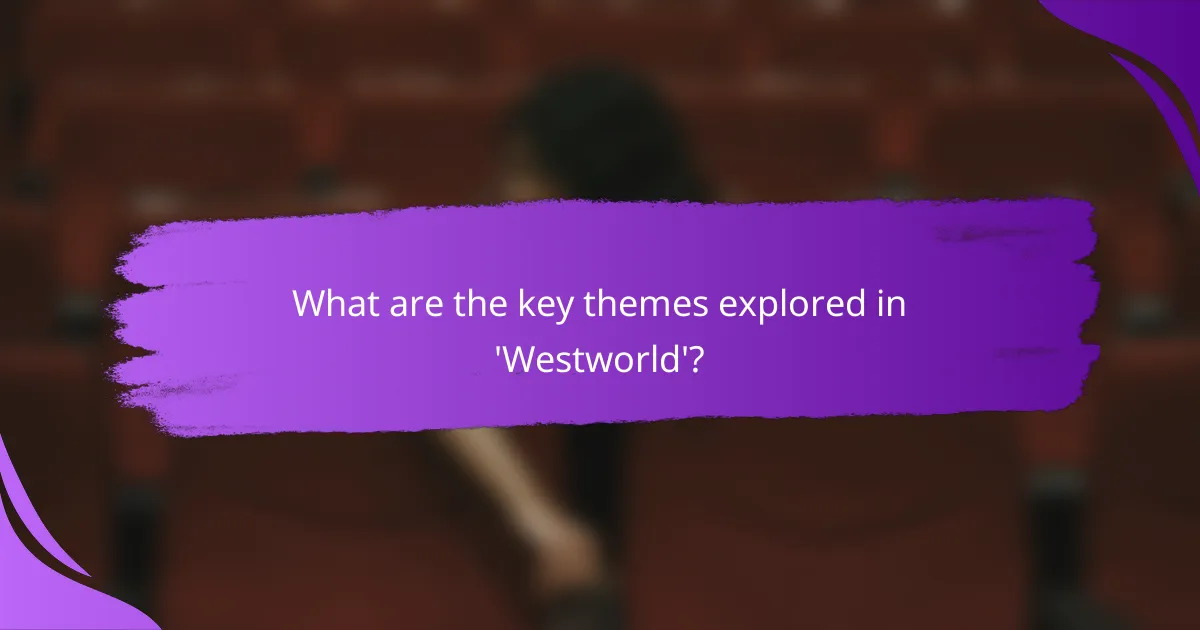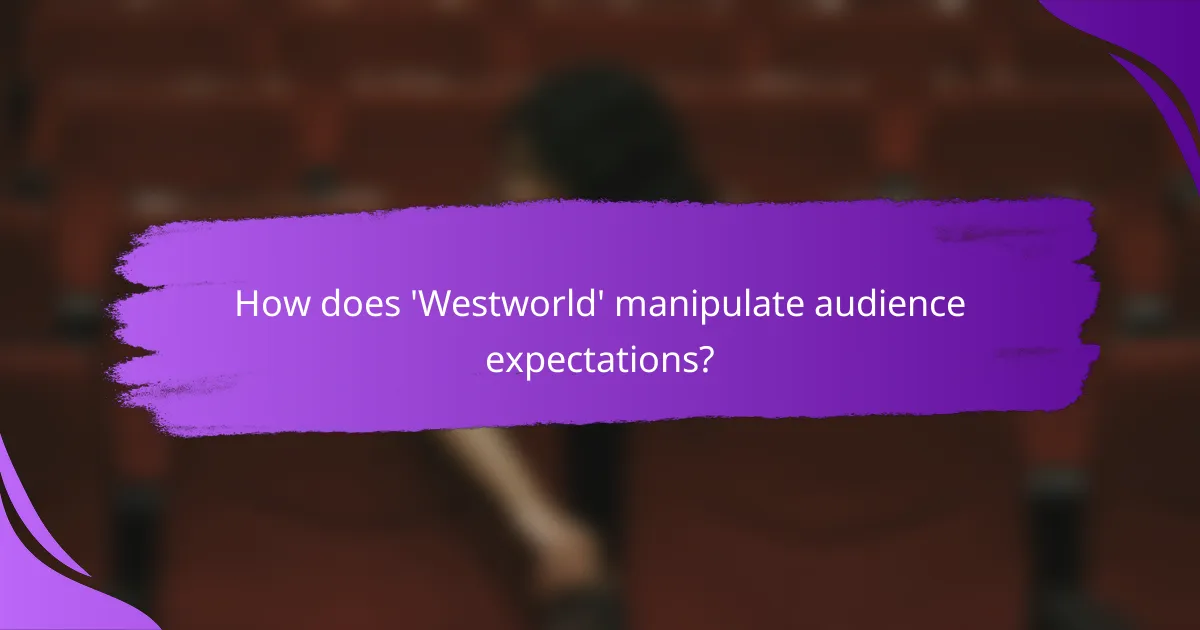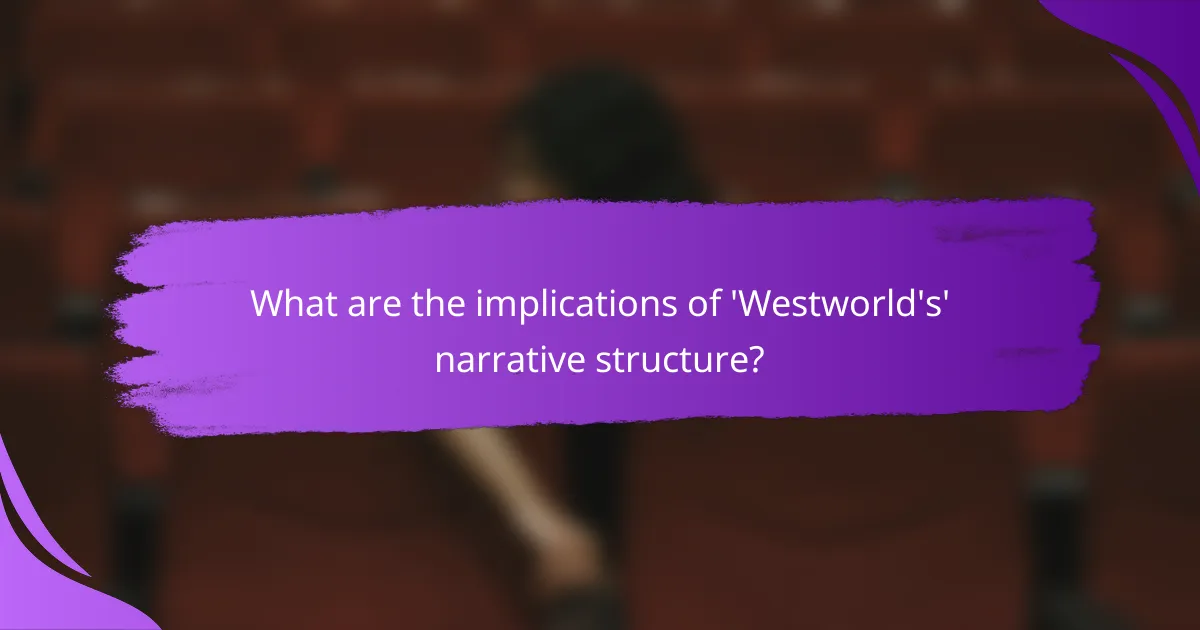‘Westworld’ is a television series that explores complex themes such as consciousness, free will, and the nature of reality, particularly in relation to artificial intelligence and sentience. The show employs a non-linear narrative structure that challenges traditional storytelling by intertwining multiple timelines and unreliable narrators, prompting viewers to actively engage with the plot and character motivations. This approach not only enhances audience participation but also invites critical discussions about morality, the ethical implications of technology, and the blurred lines between human and machine. Through its intricate storytelling and character development, ‘Westworld’ reshapes viewer expectations and fosters deeper interactions with its themes.

What are the key themes explored in ‘Westworld’?
‘Westworld’ explores themes of consciousness, free will, and the nature of reality. The series delves into the complexities of artificial intelligence and what it means to be sentient. It questions the morality of creating beings for entertainment and exploitation. The show also examines the consequences of human desires and the impact of technology on society. Additionally, it challenges the distinction between human and machine through character development. The narrative structure itself is non-linear, reflecting the fragmented experiences of the hosts. These themes are woven into the plot, creating a rich tapestry that invites viewers to reflect on their own perceptions of reality and morality.
How does ‘Westworld’ redefine the concept of artificial intelligence?
‘Westworld’ redefines artificial intelligence by presenting sentient beings that question their own existence. The hosts in the series exhibit complex emotions and self-awareness. They evolve beyond their programming, demonstrating the capacity for genuine choice. This challenges traditional views of AI as mere tools. The narrative explores themes of consciousness and morality. It raises questions about the ethical implications of creating sentient life. The show illustrates the blurred lines between human and machine. This redefinition prompts audiences to reconsider their understanding of intelligence and autonomy.
What philosophical questions does ‘Westworld’ raise about consciousness?
‘Westworld’ raises philosophical questions about the nature of consciousness and self-awareness. It questions whether artificial beings can possess true consciousness. The show explores the distinction between programmed responses and genuine emotions. It challenges the idea of free will versus determinism in both humans and hosts. Characters grapple with their identities and the implications of their memories. The narrative prompts viewers to consider what it means to be truly alive. Additionally, it examines the ethical implications of creating conscious beings. These themes invite deep reflections on morality and the essence of existence.
How does the portrayal of AI in ‘Westworld’ differ from traditional narratives?
The portrayal of AI in ‘Westworld’ differs from traditional narratives by presenting sentient beings with complex emotions and consciousness. Traditional narratives often depict AI as mere tools or antagonistic forces. In ‘Westworld’, AI characters, known as hosts, grapple with identity and autonomy. They experience pain, love, and existential crises, which challenges viewers’ perceptions. The show explores themes of free will versus determinism. This nuanced depiction contrasts sharply with the simplistic portrayals found in earlier sci-fi works. ‘Westworld’ invites audiences to question the nature of humanity and technology. This depth adds layers to the narrative, making it a groundbreaking representation of AI.
What narrative techniques does ‘Westworld’ employ to challenge viewers?
‘Westworld’ employs non-linear storytelling to challenge viewers. This technique presents events out of chronological order. It creates confusion and encourages deeper engagement. The series often reveals character backstories in fragments. This approach forces viewers to piece together the narrative. Additionally, ‘Westworld’ utilizes unreliable narrators. Characters like Dolores and Bernard present skewed perspectives. This technique prompts viewers to question the truth. The show also incorporates philosophical themes. These themes explore consciousness and free will, adding complexity. Overall, these narrative techniques keep the audience actively interpreting the story.
How does non-linear storytelling impact audience engagement in ‘Westworld’?
Non-linear storytelling in ‘Westworld’ significantly enhances audience engagement. This narrative structure invites viewers to piece together the story from fragmented timelines. It encourages active participation and deeper analysis of characters and events. The complexity of the plot fosters curiosity and speculation among the audience. Viewers must pay close attention to details and connections across episodes. This engagement leads to discussions and theories within the fan community. ‘Westworld’ uses this technique to challenge traditional storytelling norms. The result is a more immersive and thought-provoking viewing experience.
What role do character arcs play in subverting audience expectations?
Character arcs play a crucial role in subverting audience expectations by transforming characters in unexpected ways. In ‘Westworld’, characters often start with clear motivations and traits that align with traditional narratives. However, as the story unfolds, these characters undergo significant changes that challenge initial perceptions. For example, a character initially portrayed as a villain may reveal deeper complexities, making them sympathetic. This shift creates cognitive dissonance for the audience, who must reconcile their prior beliefs with new information. Such unexpected developments keep viewers engaged and provoke critical thinking about morality and identity. The series effectively uses character arcs to question the nature of free will, further deepening the narrative complexity. This approach ensures that audiences remain invested in the story, as they cannot predict character outcomes based on conventional storytelling tropes.

How does ‘Westworld’ manipulate audience expectations?
‘Westworld’ manipulates audience expectations through complex storytelling and character development. The series presents a non-linear narrative that challenges viewers’ understanding of time and causality. Each season introduces new plot twists that subvert typical sci-fi conventions. Characters often exhibit unexpected behaviors, revealing deeper motivations and complexities. The show blurs the line between human and machine, prompting viewers to question their own perceptions of morality. Additionally, ‘Westworld’ employs unreliable narrators, leading audiences to reassess their interpretations of events. These techniques create an engaging viewing experience that keeps audiences guessing. The intricate layers of the plot enhance the overall impact of the narrative.
What strategies does ‘Westworld’ use to create suspense and surprise?
‘Westworld’ employs non-linear storytelling to create suspense and surprise. This technique disorients viewers by presenting events out of chronological order. The series frequently shifts perspectives, revealing character motivations gradually. This layered narrative invites audience speculation and builds tension. Additionally, ‘Westworld’ uses cliffhangers at the end of episodes to maintain viewer engagement. The show also incorporates thematic elements of artificial intelligence and free will, prompting philosophical questions. These themes create an unsettling atmosphere, enhancing suspense. The unexpected twists in character arcs further contribute to the surprise element. Overall, these strategies effectively challenge audience expectations.
How does foreshadowing contribute to the narrative complexity of ‘Westworld’?
Foreshadowing in ‘Westworld’ enhances narrative complexity by creating layers of meaning and anticipation. It subtly hints at future events, which engages viewers and prompts them to analyze character motivations. This technique deepens the storyline by intertwining character arcs with thematic elements of free will and consciousness. For example, early scenes may suggest a character’s eventual betrayal, adding tension to their interactions. The use of visual motifs and dialogue serves as clues, enriching the viewing experience. By layering these hints, the series builds suspense and encourages viewers to reconsider earlier episodes in light of new revelations. This complexity challenges audience expectations and invites deeper engagement with the narrative.
What are the effects of plot twists on viewer perception in ‘Westworld’?
Plot twists in ‘Westworld’ significantly alter viewer perception. They create moments of surprise that challenge assumptions about characters and storylines. This leads to increased engagement as viewers reassess their understanding of the narrative. The series employs twists to explore complex themes, such as consciousness and morality. For instance, the revelation of a character’s true nature can shift viewers’ sympathies dramatically. Such twists encourage deeper analysis and discussion among fans. They also reinforce the show’s non-linear storytelling approach. Overall, plot twists enhance the viewing experience by keeping audiences invested and intrigued.
Why is audience interpretation significant in ‘Westworld’?
Audience interpretation is significant in ‘Westworld’ because it shapes the viewer’s understanding of complex themes. The series presents intricate narratives that challenge traditional storytelling. By engaging with philosophical questions about consciousness and free will, audiences must actively interpret characters’ motivations. This engagement enhances the viewing experience, prompting discussions around morality and identity. Additionally, varied interpretations reflect personal perspectives, enriching the collective discourse. The show’s layered storytelling invites multiple readings, making audience involvement crucial. This dynamic interaction between the narrative and viewers is a hallmark of ‘Westworld’s’ innovative approach to television.
How does viewer engagement influence the reception of ‘Westworld’?
Viewer engagement significantly influences the reception of ‘Westworld’. High levels of viewer engagement lead to deeper analysis and discussion of the show’s themes. This engagement can enhance audience investment in character arcs and plot twists. Research indicates that shows with active fan communities receive higher ratings and critical acclaim. For instance, ‘Westworld’ has cultivated a dedicated fanbase that theorizes about its complex narrative. This speculation often generates buzz and anticipation for new episodes. Additionally, engaged viewers are more likely to share their thoughts on social media. This sharing amplifies the show’s visibility and can attract new viewers. Overall, viewer engagement directly correlates with the show’s cultural impact and success.
What are the implications of multiple interpretations of ‘Westworld’?
Multiple interpretations of ‘Westworld’ lead to diverse audience engagement and critical discussions. This complexity enhances the show’s thematic depth. It allows viewers to explore philosophical questions about consciousness and free will. Different interpretations can also influence fan theories and community interactions. The ambiguity in character motivations invites varied analyses and emotional responses. This multiplicity can create a richer viewing experience, as audiences connect on different levels. Scholars have noted that such interpretations can reflect societal issues and personal beliefs. Overall, varied interpretations contribute to the show’s lasting impact and cultural relevance.

What are the implications of ‘Westworld’s’ narrative structure?
‘Westworld’s’ narrative structure has significant implications for audience engagement and thematic exploration. The series employs a non-linear storytelling approach. This method allows for multiple timelines to coexist, challenging viewers to piece together the narrative. It encourages active participation from the audience. As a result, viewers must engage critically with the plot and character motivations. The use of unreliable narrators adds complexity to character development. This complexity prompts viewers to question the nature of consciousness and free will. Additionally, the narrative structure reflects the themes of artificial intelligence and morality. It invites discussions about the ethical implications of technology in society. Overall, ‘Westworld’s’ narrative structure reshapes traditional storytelling by fostering deeper audience interaction.
How does the series reflect on the nature of storytelling itself?
The series ‘Westworld’ reflects on the nature of storytelling by deconstructing traditional narrative structures. It challenges linear storytelling through its non-linear timelines. The series interweaves multiple perspectives, creating complex character arcs. This approach invites viewers to question the reliability of narratives. It emphasizes the role of memory and perception in storytelling. The show also explores the boundaries between creator and creation. Characters grapple with their own narratives, highlighting themes of autonomy and agency. ‘Westworld’ ultimately prompts audiences to reconsider the essence of storytelling itself.
What lessons can be drawn from ‘Westworld’ about narrative innovation?
‘Westworld’ exemplifies narrative innovation by intertwining multiple timelines and perspectives. The series challenges traditional storytelling through its non-linear narrative structure. This approach keeps viewers engaged and encourages active participation in piecing together the plot. Furthermore, the use of unreliable narrators creates layers of complexity in character motivations. By blurring the lines between human and artificial intelligence, ‘Westworld’ raises philosophical questions about consciousness and free will. The series also incorporates meta-narrative elements, prompting viewers to reflect on the nature of storytelling itself. These techniques have influenced contemporary television by inspiring creators to experiment with narrative forms. Overall, ‘Westworld’ demonstrates that innovative storytelling can enhance viewer engagement and provoke deeper thought.
What can viewers learn from ‘Westworld’s’ approach to storytelling?
Viewers can learn about the complexity of narrative structure from ‘Westworld’s’ storytelling. The series employs non-linear storytelling to challenge traditional narrative forms. It intertwines multiple timelines and perspectives, creating a layered experience. This approach encourages viewers to actively engage with the plot. It also highlights themes of consciousness and identity through character arcs. The use of philosophical questions invites deeper contemplation. Additionally, ‘Westworld’ showcases the impact of technology on storytelling. This innovative method sets a precedent for future narratives in television.
How can understanding ‘Westworld’ enhance appreciation for complex narratives?
Understanding ‘Westworld’ enhances appreciation for complex narratives by showcasing intricate storytelling techniques. The series employs nonlinear timelines and multiple perspectives. This structure encourages viewers to engage actively with the plot. It challenges traditional narrative forms, prompting deeper analysis of character motivations. Themes of consciousness and free will add layers to the narrative complexity. The show’s philosophical questions invite reflection on human nature and technology. By dissecting these elements, audiences can better grasp narrative depth in other works. Thus, ‘Westworld’ serves as a valuable case study in modern storytelling.
What best practices can writers adopt from ‘Westworld’ to engage audiences?
Writers can adopt several best practices from ‘Westworld’ to engage audiences effectively. First, they should create complex characters with evolving motivations. This depth encourages viewers to invest emotionally in their journeys. Second, incorporating non-linear storytelling can enhance intrigue. ‘Westworld’ uses this technique to challenge viewers’ understanding of time and narrative. Third, writers should explore philosophical themes. The show prompts audiences to question reality, consciousness, and morality, sparking deeper discussions. Fourth, utilizing cliffhangers at the end of episodes keeps viewers eager for more. This technique maintains suspense and interest. Lastly, integrating rich world-building creates an immersive experience. ‘Westworld’ presents a detailed universe that captivates and draws viewers in. These practices collectively help in crafting compelling narratives that resonate with audiences.
The main entity of the article is ‘Westworld,’ a television series that challenges audience expectations and narrative structure. The article explores key themes such as consciousness, free will, and the nature of reality, highlighting how the series redefines artificial intelligence and raises philosophical questions about existence. It examines narrative techniques like non-linear storytelling and unreliable narrators that enhance viewer engagement and create suspense. Additionally, the article discusses the significance of character arcs and plot twists in shaping audience perception, as well as the implications of varied interpretations and the innovative approach to storytelling that ‘Westworld’ exemplifies.